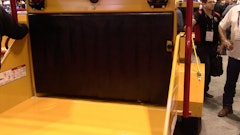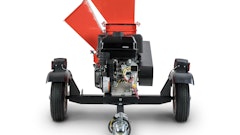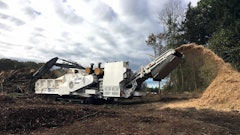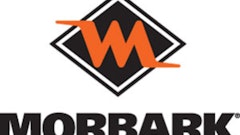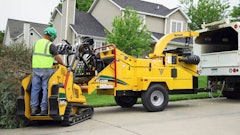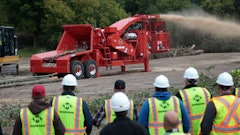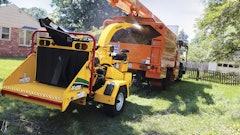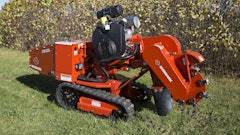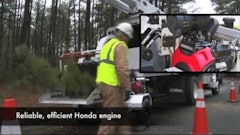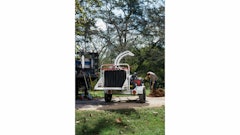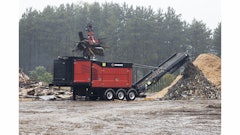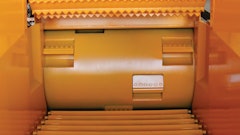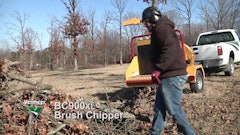
When your customers have to clear land for a project, trees and brush need to be taken care of fast and safely. Brush chipper manufacturers have developed various features and options that can help maximize productivity and safety while reducing labor costs during chipping.
The benefits of these features for your rental customers include reduced potential for injury and repetitive motion ailments. According to Rob Faber, commercial sales specialist at Morbark, the benefits for you, the rental business, include a possible reduction in insurance costs and liability concerns.
When selecting a chipper for your rental inventory, take a look at the following features that are available on some of today's brush chippers.
Automatic feed systems
Recently, systems have gotten "smarter" when it comes to drawing brush and limbs into a chipper. According to Faber, an automatic feed system, which is standard on Morbark machines, takes the guesswork away from the operator - there is less threat of stalling or overfeeding the machine.
"There are different styles of automatic feed systems, but most use rpm sensors," says Faber. "When a preset rpm is reached, the sensor will stop the feed wheels. Often, this is followed by a reverse action to clear the material. The operator doesn't have to stand next to a control bar to feed in material and monitor operations as closely now."
Bandit Industries offers the Auto Feed Plus on its 9- and 18-inch-diameter hand-fed chippers. This feature "is a symphony between the chipper and the feed wheels," says Leslie Kinnee.
"Our feed systems are set so the material is fed to the disc at the rate the chipper wants to chip it," explains Kinnee. "Because the hydraulic pump drives off the engine, as the engine rpm drops, so does the speed of the feed wheels. In this way, the feed system is always in harmony with the chipper."
Kinnee further notes that with this feed system, wood is never pushed against the disc, which can cause a braking action and can heat the disc and knives, prematurely dulling the knives. "Holding wood back from the disc will result in short cut material and can cause material to ball up in the infeed chute," she says. "These feed systems make the machines run smother with less vibration, reducing maintenance. They also ensure uniform chip size."
Vermeer brush chippers have features like the AutoFeed II system or SmartFeed. These patented feed-sensing control systems address predictability, or how quickly the engine loses rpm, rather than reacting based on a predetermined machine setting. The controller will only allow the engine rpm to drop slightly before stopping hydraulic flow to the feed rollers. Once they've stopped, if the engine doesn't return to full rpm within a set time, the roller will automatically reverse the material. This minimizes contact between the wood and the drum to relieve friction. It also allows the drum to return to full rpm as quickly as possible and resume automatic feeding - without operator involvement.
For small-diameter or loose, brushy material, the feature senses extended rpm loss time. It commands the engine to drop to a lower rpm while retaining maximum torque. This helps increase brush chipper productivity because it decreases the number of stops and starts while brushy material is processed. It also helps reduce the chance of self-feeding at a low rpm.
For increased operator safety around the infeed area, ANSI and OSHA set standards requiring the ability to quickly stop or reverse the device. Most manufacturers follow these standards.
Bandit also includes a patented last-chance pull stop cable as standard on its hand-fed chippers. It consists of two cables hanging about halfway between the hopper entrance and the feed wheels. If an operator incorrectly finds himself past the feed control bar and inside the hopper, he can use the cable to stop or reverse the feed wheels and wood flow.
Morbark also offers a cable system in its infeed, as well as an 87-inch-long feed table length to keep people further away from the feed system.
Vermeer has a patented "bottom feed stop bar." Combined with the stop bar is a four-position upper feed control bar with dual stop positions and forward/reverse feed positions. Mounted over the feed table, this control bar provides a means for the operator to stop the feed rollers as well as selecting forward or reverse feed operations.
Winches save backs, deliver labor savings
These hydraulic assistants help operators bring big material to the chipper and pile it into the feed system with much less labor and fatigue. Winches allow operators to pull material into the chipper that might not be accessible or easy to move using other conventional methods, such as a skid steer.
"You're more likely to chip more of the tree when you use a winch," says Faber with Morbark, which offers this option for about $2,500 on its 12- to 18-inch-diameter models. "There's less chain saw work."
Winches are optional on some models of Vermeer brush chippers. Chris Nichols, sales manager with Vermeer, says that most rental businesses don't carry brush chippers with winches, because typical rental customers don't engage in projects that would require them. "Unless a rental store has customers who require larger, more productive brush chippers, rental stores generally purchase smaller machines without the optional winch," he notes.
While you usually won't find a winch on the smaller 6- or 9-inch units, they are becoming more popular when clearing large material from a jobsite.
"Winches are great for pulling large material and bundles of material that are too heavy to carry by hand to the chipper," says Kinnee with Bandit. Bandit's winch retails for about $1,800 and is available with a remote control.
"This option can be a tremendous back saver and can eliminate a lot of trimming and chain saw work, especially when processing large material," Kinnee continues. "It can also take a lot of labor out of chipping brush by moving bundles of material from a distance to the chipper. The winch is also a useful tool to work in conjunction with an aerial lift in guiding portions of the tree in full tree take down applications to the chipper."
Rental considerations
Customer safety is always at the top of the list with rental businesses. When selecting a chipper, ease of use is important, says Faber. "Make sure the chipper is user-friendly and simple to operate," he explains. "The easier it is to use, the better. Customers - although we always remind them - don't always read the owner's manual. So we try to make it as simple as possible."
Maintenance issues are another top concern with rental businesses, so it's only natural to keep ease-of-repair features in mind when selecting a brush chipper for your inventory.
"Changing knives is a big issue with chippers," says Faber. "Rental businesses should check knife wear after every rental, so easy access to that is very important."
Dealer service support and local training availability relates back to safety and maintenance, therefore keep it in mind when selecting a chipper.
"Rental stores rely heavily on local dealer service support should mechanical issues develop," says Nichols. "If a brush chipper requires repair, readily available parts and service from the dealer will aid in getting the machine back on the rental list more quickly. Dealer training is also essential for rental stores, so rental store employees can train customers on how to properly operate the equipment."
|
Available chipper options Chipper manufacturers have devised various options to help make your customers' jobs easier and more productive. They include:
When it comes to selecting a chipper, sources emphasize that you know your customer base and what they'll most likely need. "When choosing options, make sure they're viable - money-making - choices," says Rob Faber with Morbark. "For example, you probably won't need a large-diameter unit with a loader arm if your customer base is mostly residential." |




